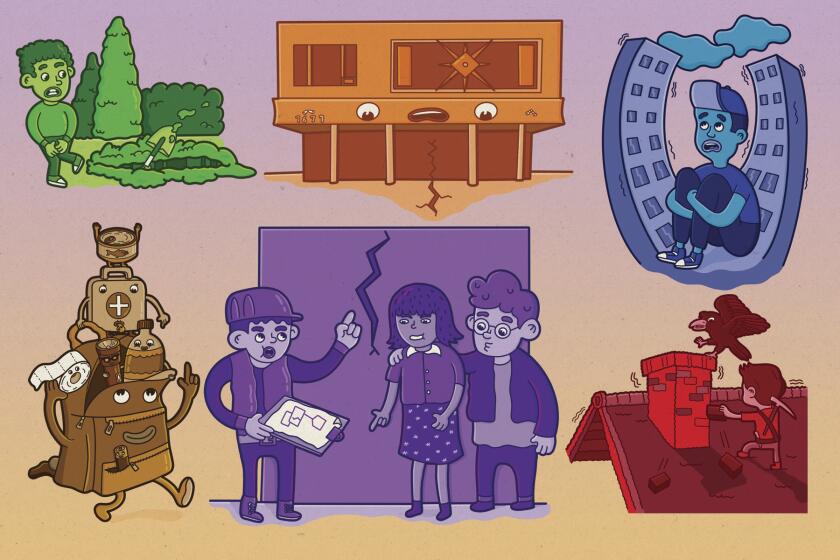The California ShakeOut is just a drill. Are you ready for a real earthquake?

- Share via
Around California today, people heard sirens and got alerts on their cellphones about earthquakes. But it wasn’t the Big One coming to disrupt our lives and destroy our infrastructure. It was the Great California ShakeOut, an annual test of the state’s earthquake readiness and a reminder for Californians to be prepared for a major temblor.
If those sirens and alerts left you wondering how to make sure you, your family and your neighborhood will be OK in the event of a real quake, The Times and other organizations have lots of resources to help. Here’s a rundown.
Get ready
Start by signing up for Unshaken, The Times’ six-week newsletter course that will help you get prepared for an earthquake without getting stressed. You’ll learn about earthquake kits, things you can do to make your home safer, and improvements you’ll probably have to hire a professional to make. Unshaken also offers tips for preparing your finances, including guidance on earthquake insurance.
Get earthquake-ready in six weeks
From building a kit to buying insurance, our Unshaken newsletter course will help you prepare.
You may occasionally receive promotional content from the Los Angeles Times.
Then make sure you have the MyShake app on your phone. If you already have it, check the settings to ensure that you’ll get alerts for your region. There are lots of other earthquake apps, as well. Here’s how to make sense of them.
If you’re thinking of building an earthquake kit from scratch or buying a pre-made one, watch our unboxing video. The Times’ Jenn Harris and Lucas Kwan Peterson opened up kits costing $30 to $300 to see what’s inside and, because they love and write about food, how the emergency rations tasted. (Spoiler: Not great.)
Southern California homeowners should evaluate whether seismic retrofitting makes sense for them. Older homes and those with raised foundations and brick chimneys may need special attention.
Do you live or work near the ocean? Here’s what you need to know about tsunamis.
Consider that the most important thing you can do before an earthquake may be to talk to your neighbors. That’s the perspective of seismologist Lucy Jones, who says people are more important than kits and that strong neighborhood bonds are what will help Southern California recover after a devastating quake.
For more, watch a video of the Local Matters event on earthquake readiness and resilience with The Times’ Rong-Gong Lin II and Patt Morrison, KPCC/LAist’s Jacob Margolis and Austin Cross and seismologist Jones.
A major earthquake in California is likely to knock out many communications services, including cellphones, for days or weeks, a USGS study finds.
During a quake
While the earth is shaking, the most important thing is your physical safety — and the best course of action is to drop, cover and hold on. Do not run outside. Do not stand in a door frame. Do not attempt a debunked self-preservation approach called the triangle of life.
- Drop: Get underneath something sturdy, such as a table or desk.
- Cover: Make sure your head and neck are protected.
- Hold on: Until the shaking stops, grab that sturdy furniture and don’t move.
When the Big One hits, will Californians be ready for a lack of modern communication connections? Extended periods without essential utilities such as water and gas? Damage to homes? The mental health effects that often follow disaster?
Further reading
California has an earthquake early-warning system. Many of us heard a test of it today. How does ours compare with the warning systems in Japan and Mexico?
Children are bound to have questions and concerns about quakes. Here’s how to talk to them and help them prepare.
People with disabilities may need to make special considerations when preparing.
Purchasing earthquake kits and extra supplies can be a financial burden. But there are ways for people with low incomes to be ready.
Angelenos love our pets. Here’s what your animals need from you before, during and after an earthquake.
Ready.gov has a site dedicated to earthquake preparedness, including checklists for earthquake kits.
The Earthquake Country Alliance also has extensive resources on preparation, survival and recovery.
KPCC and LAist produced a podcast called the Big One about what could happen in a major earthquake. The news organization also has resources and guides, including one about storing water.
More to Read
Sign up for Essential California
The most important California stories and recommendations in your inbox every morning.
You may occasionally receive promotional content from the Los Angeles Times.












